Multi-scale Mechanical Properties Laboratory
The Multi-scale Mechanical Properties Laboratory conducts cutting edge research into understanding the deformation behavior of polymers, metals, ceramics, and their composites. A spectrum of instruments from low-load atomic force microscope to high-load tensile tester is used to unravel the mechanical responses in these materials in a wide range of length scales from few nanometers to few centimeters. This is particularly beneficial for obtaining a comprehensive understanding responses in materials with hierarchical structural features at multiple length scales.
These instruments provide insights into stiffness of 2D layered materials, biological tissues, inter metallic precipitates in metals, and interfaces in ultra-high temperature ceramic materials. The role of hardness and elastic modulus of these microstructural features on the overall, behavior of the materials is acquired by several bulk strength and plasticity testing devices. The impact of elevated temperature on these plasticity characteristics of these materials is also measured by high-temperature modules integrated with these instruments

Tools
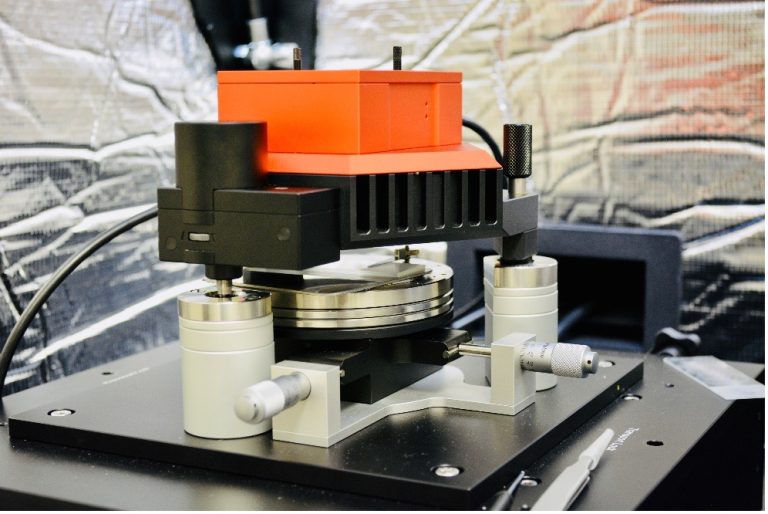
Nanosurf FlexAFM
The Nanosurf FlexAFM instrument, equipped with a sample stage compatible with inverted microscopes, is made for analyzing the topographical, electrical, and mechanical attributes of 0D, 1D, and 2D materials as well as composites. This tool excels in providing atomic-level resolution images through static force, lateral force, dynamic force, and phase imaging modes. It is highly capable in the mechanical characterization of materials, offering functionalities such as force spectroscopy, force modulation, and measurements of stiffness, modulus, adhesion, as well as modulus mapping and scratch testing. Furthermore, its integration with a FluidFM microfluidic tool enables precise single-cell biological studies and nanomanipulation tasks with piconewton-level force sensitivity. In its Kelvin probe force microscopy (KPFM) mode, the instrument can investigate surface contact potential variations. It has been effectively utilized in research involving quantum dots, single fibers, graphene, boron nitride nanotubes, boron nitride nanoplates, MXenes, MoS2, polymer composites, gold nanorods embedded in hydrogels, and thin films of tungsten oxide, nickel oxide, and lanthanide oxide.
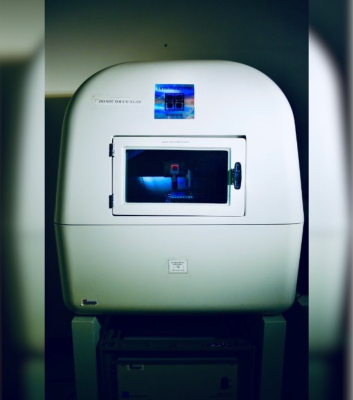
Bruker T1 900 Nanoindenter
The Bruker TI 900 is a high resolution nanoindenter that enables the investigation of mechanical behavior of materials at extremely small length scales of few nanometers. This helps in understanding the elastic modulus, hardness, and scratch resistance in a diverse range of materials such as metals, ceramics, polymers, and composites. The TI-900 can employ a multitude of indenter geometries including the Berkovich, Cube corner, Spherical in conventional and fluid cell configurations for testing a wide variety of samples from soft tissues to hard ceramics in ambient and immersed environments. The high resolution is particularly useful for understanding stiffening in metals and composites from alloy precipitation and reinforcements. ColRAD researchers are using this instrument to investigate mechanical responses in heat treated metals, feedstock powder, biological tissues, and single fibers of polymers.
Features/Specifications:
Max Force: 10mN
Load Resolution: 1 nN
Max Displacement: 5 µm
Displacement Resolution: 0.04 nm
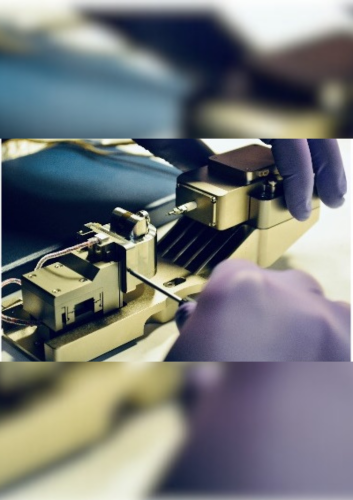
In-situ Nanoindenter PI 87
The Hysitron PI 87 is an advanced depth-sensing mechanical test instrument specifically designed for integration with scanning electron microscopes (SEM) or FIB/SEM systems. Operating within the SEM allows for real-time visualization of experiments, offering invaluable insights into deformation mechanisms and material interactions. This system enables simultaneous quantitative nanomechanical testing and imaging, making it highly effective for analyzing fracture onset, crack propagation, delamination, and pile-up in materials. The instrument utilizes diamond probes to perform nano- to micro-scale mechanical testing, generating load-displacement curves that elucidate material behavior such as hardness and elastic modulus. Furthermore, experiments can be conducted across a wide temperature range and with various probe sizes and geometries, enhancing versatility and applicability. Our lateral stage allows for scratch testing of samples to determine COF and scratch deformation mechanisms.
Features/Specifications:
Maximum Force: 150 mN
Force Noize Floor: <400 nN
Maximum Displacement: 500 µm
Displacement Noise Floor: <1 nm
Motorized X Travel: 12 mm
Motorized Y Travel: 16 mm
Temperature: <800°C
Tips: Berkovich, Cube Corner, Conospherical, Flat Punch
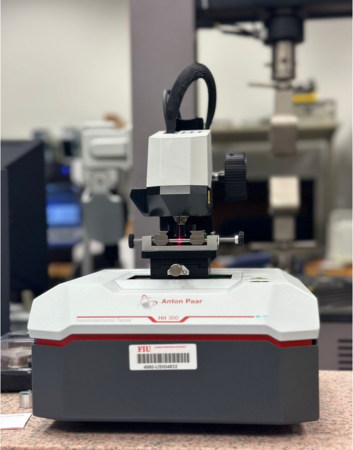
HIT 300 Nanoindenter
The HIT 300 offers high throughput nanomechanical testing, performing up to 600 hourly measurements. Versatile across polymers, metals, ceramics, and composites, its active anti-vibration damping ensures accuracy in dynamic conditions. With dual laser targeting and a top surface reference ring, it provides precise positioning and shields against thermal drift, ensuring consistent, reliable results for comprehensive material analysis.
Features/Specifications:
Diamond Berkovich indenter
Quasistatic and dynamic mechanical analysis
Load range: 1 to 500 mN
Load resolution: 0.02 µN
Depth range: 200 µm
Depth resolution: 0.01 nm
Motorized X table travel range: 40 mm
Manual Y table travel range: 40 mm
Active anti-vibration table
Laser indicating crosshair indentation position.
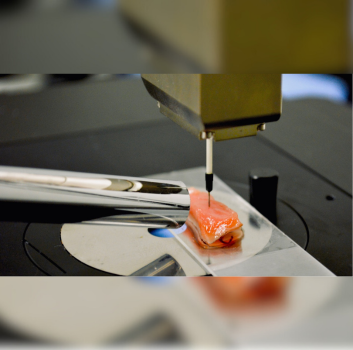
Biosoft Nanoindenter
The Hysitron Biosoft instrument featuring an in-situ indenter, a displacement capacity up to 150 µm and a load capacity up to 10 mN, is specifically applied for the nanomechanical characterization of soft and ultrasoft biological materials and matter. This instrument is adept at capturing single-measurement and low-frequency fatigue tests, which can be conducted under load-control or displacement-control modes, with the option to include a hold period. Its integrated capabilities, including proprietary software and a multi-camera system, enable researchers to determine in-situ mechanical responses and the elastic modulus of the tested materials, ranging from 0.5 kPa to a few GPa. Additionally, a plate-heat control system has been integrated into the device, allowing for quantitative in-situ mechanical testing at room temperature to 60°C, with an accuracy of 0.1°C. It has been successfully utilized to measure mechanical responses in dry and wet conditions of single fibers, hydrogels, living-engineered cardiac tissues, 3D printed scaffolds, two-photon polymerization scaffolds, biological tissues, PDMS micropillars, and thin films.
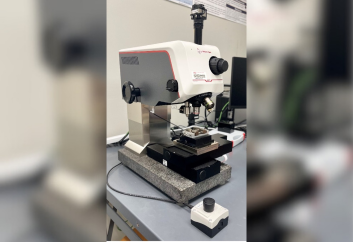
Revetest Scratch Tester
The Antonpaar RST3 hardness tester stands out as a sophisticated and versatile instrument capable of delivering precise hardness measurements across multiple scales and materials. At ColRAD, we utilize the RST3 to probe the hardness of coatings and monolithic deposits of polymers, ceramics, and metals at multiscale levels, ranging from individual grains and grain boundaries to various microstructural features. With a broad spectrum of load range from 1 to 200 N, our system ensures adaptability to different materials and testing scenarios. Additionally, the RST3 is equipped with a mounted Vickers indenter coupled with a microscope offering 5x and 10x magnification, enabling us to specifically target microscopic features and conduct post-indent imaging for detailed analysis.
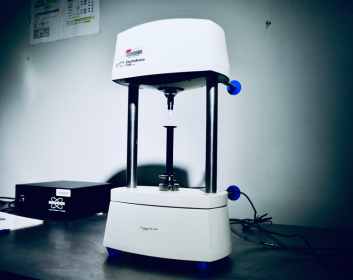
ElectroForce 3100
The ElectroForce 3100 by TA Instruments is a low-load mechanical testing instrument that is renowned for its versatility and precision. Due to its high precision at low loads, the ElectroForce 3100 serves as a valuable instrument in materials science, especially in polymers and biomaterials research. This instrument is commonly used for tensile, compression, dynamic mechanical analysis (DMA), fatigue testing, and other mechanical characterizations in the meso- and macro scale.
The system incorporates three load cells, enabling measurements at 250 gf, 1000 gf, and 22 N loads. This high load range significantly enhances its testing adaptability, broadening the range of materials that can be mechanically characterized. The design and functionalities of the ElectroForce 3100 enable detailed examinations of material mechanical behavior under various conditions.
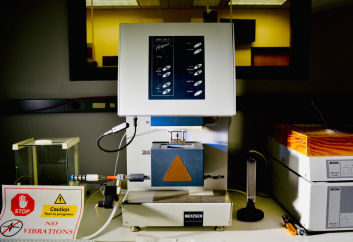
Dynamic Mechanical Analyzer (DMA)
The Dynamic Mechanical Analyzer is a high-sensitivity instrument to assess the stiffness, damping, viscosity, and aging characteristics of materials. It is equipped with multiple testing geometries under 3-point bending, single/dual cantilever bending, shearing, tension, and compression modes. Specimens of metals, polymers, and composites, at length scale of few centimeters can be reliably investigated. The instrument is connected to liquid nitrogen, an integrated furnace, and a nitrogen supply enabling investigating mechanical responses under cryogenic and elevated temperatures as well as under inert environments. This instrument is being utilized to understand the static and dynamic mechanical responses of materials under quasi-static and cyclic fatigue loading conditions.
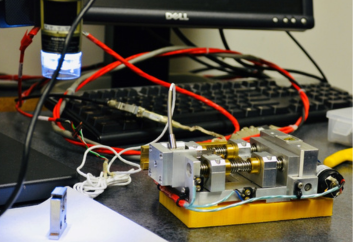
In-situ Tensile Testing (MTI)
The MTI tensile tester is a multifaceted micro-mechanical testing instrument, facilitating a wide array of tests including tensile, compression, 3 & 4 point bending, fatigue, and composite debonding analyses. Notably, these tests can be conducted both within and outside the Scanning Electron Microscope (SEM), affording the unique capability to pinpoint localized mechanical deformation mechanisms and crack initiation sites with exceptional clarity.
Featuring the flexibility to employ two distinct load cells – 400N or 4000N – and offering a maximum displacement of 30mm, the MTI tensile tester ensures precise and reliable experimental conditions across various testing scenarios. This versatility makes it an invaluable tool for researchers and engineers alike, enabling comprehensive investigations into the mechanical properties and behaviors of diverse materials and structures.
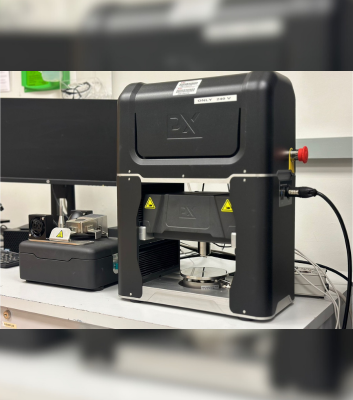
Profilometry-based Indentation Plastometry (PIP)
Researchers employ the Profilometry-based Indentation Plastometry (PIP) (Make: Plastometrex, Model: PLX Plastometrex v.1.0) to advance high-throughput mechanical testing of materials. This technique allows indentation using ultra-high load (up to 9 kN) at ambient and elevated temperature (up to 800oC), offering a new insight in material tensile response. It has a remarkable ability to extract bulk stress-strain curves, yield and tensile strength from a small sample size, resulting in substantial time and material resource savings. Our current research activities are heavily focused on leveraging the power of PIP for evaluating the mechanical properties of Aluminum alloys and Titanium, manufactured using Additive Manufacturing techniques like Cold Spray Additive Manufacturing (CSAM) and Wire Direct Energy Deposition (WDED).
Features/Specifications:
Maximum Load: 9 kN
Load Resolution: 0.1 N
LVDT Resolution: 0.3 µm
Prolifometer Resolution: 0.4 µm
Indenter Radius: 0.5 mm & 1 mm
Operating Temperature: 5 to 800 °C
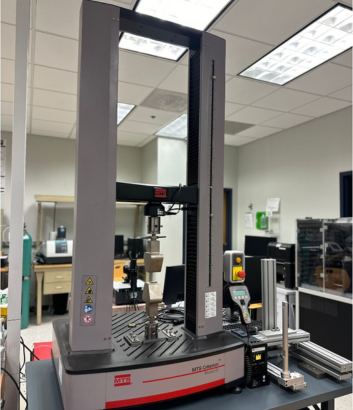
MTS Tensile Tester
MTS Criterion universal testing tool offers bulk scale tensile, compression and bending testing of range of materials including thin film plastics to very high strength structural steel or ceramics. The 30 kN load frame system has multiple load cells, multiple effectors, extensometer and a high temperature chamber. Multiple load cells can be piggybacked to the system to reduce the maximum load capacity and enhance the force resolution. Monotonic tensile testing from room temperature up to 1000 °C helps simulate the mechanical properties including yield and tensile strength, elongation and modulus of elasticity at elevated temperatures. Additionally, the compression and bending properties of the materials can be evaluated. By measuring the force applied and the resulting deformation, the material properties can be determined, aiding in material characterization, tailoring material processing conditions, and development efforts. Capable of In-situ digital image correlation when an external camera is attached.
Features/Specifications:
Load Capacity: Load Cells of 30 kN, 5 kN and 5 N
Maximum Speed: 1020 mm/min
Extensometer Gage Length: 10 mm, travel ±1.5 mm
Environmental Simulation: Hot Furnace up to 1000 °C
